I spent three years creating product-led blog posts and case studies for B2B SaaS companies before I realized something obvious: sales enablement content credibility determines whether reps will actually use what you create. When a rep shared my article in a prospect conversation or referenced a customer story during a demo, that content became part of their selling motion — whether I’d intended it to or not.
In HubSpot’s 2025 State of Sales report, nearly 28% of salespeople identified making more effective use of sales enablement content as a focus area for the year ahead. That signals reps know the materials exist but struggle to figure out when and how to use them in live sales situations.
In this article, I’ll walk through why sales enablement content deserves your attention right now, how to create material reps will use, and real-world tips from sales professionals on what makes enablement content resonate.
Table of Contents
- Why Sales Enablement Content Matters
- How to Create Winning Sales Enablement Content
- Real World Sales Enablement Tips
Why Sales Enablement Content Matters
Sales enablement content used to be an afterthought — something you created once reps asked for it. That’s no longer the case. The way buyers research, the channels that drive pipeline, and what reps need to close deals have all shifted in ways that make enablement content central to revenue growth.
Here’s what the data reveals about these shifts.
Buyers expect tangible value before they commit.
When buyers can demonstrate value to themselves, sales enablement content becomes the bridge between research and purchase.
The data shows this clearly: 37% of buyers see product fit as their deciding factor, and 35% need to justify value for money.
Sales teams are responding by expanding self-serve tools — 40% now offer free trials, pricing pages, and customer stories that let buyers evaluate solutions independently. Another 35% have shifted to solution-based selling, which requires content that connects specific problems to measurable outcomes.
Your enablement materials need to demonstrate value in concrete terms — through use cases, ROI calculators, and customer proof points, so buyers can build confidence in their decision and reps can reinforce that confidence when they enter the conversation.
AI is reshaping the research process.
Buyers arrive at sales conversations more informed than ever, which changes what reps need from enablement content.
The seller‘s role has shifted since 36% say their most important job is now helping buyers feel confident in their decisions, and 33% focus on navigating internal buy-in. This means your content needs to address the specific doubts and political hurdles buyers face after they’ve done their research.
Think fewer product explainers and more content that tackles objections, builds consensus among stakeholders, and provides the proof points buyers need to justify their choice internally.
Social media drives pipeline.
Social media has moved from a brand-building channel to a lead generation engine.
It delivers the highest cold outreach response rate at 42% — well ahead of email (26%) and phone calls (23%). It’s also the top source of high-quality leads, with 35% of sales teams ranking it first.
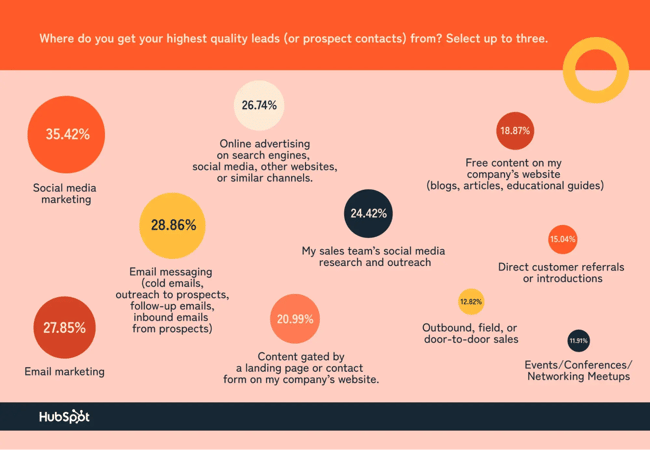
Most telling: 45% of sales professionals rate social media as “very effective” at driving sales, outperforming even in-person meetings (44%). This means your enablement content needs to be shareable and built for social channels.
Reps need assets they can post directly or send in DMs — bite-sized insights, customer stories, and data points that initiate conversations rather than requiring someone to download a white paper or sit through a demo first.
Reps need to showcase value throughout the journey.
Closing a deal is one thing. Keeping that customer and growing the account is another.
The data shows that three of the top five strategies for driving upsells center on proving value:
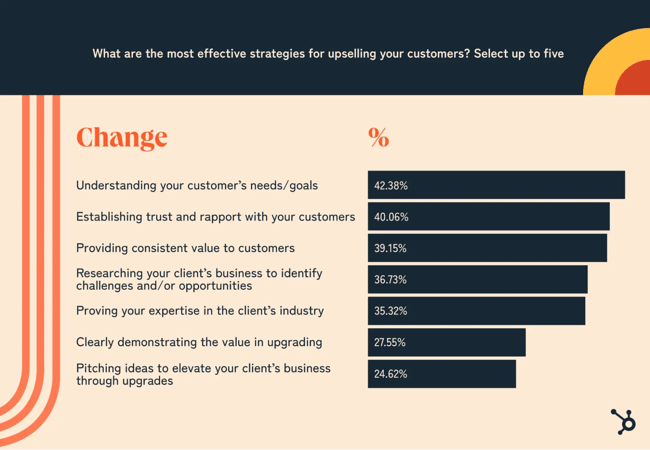
The timing matters too, since 37% report that the best moment to pitch an upsell is right after you‘ve helped a client hit their goals, when trust is high and the results speak for themselves. This means your enablement content can’t stop at the first sale.
Reps need materials that help them track wins, show progress toward what customers care about, and frame expansion opportunities around the outcomes they’ve already delivered.
How to Create Winning Sales Enablement Content
Creating enablement content that reps use comes down to one thing: starting where they are instead of where you wish they were.
If you build content in a vacuum — writing what sounds logical without testing it against conversations — you’ll end up with materials that sit unused in a shared drive.
The approach below works differently. It’s built on listening first, then creating content that fits into the conversations reps are already having.
1. Start with conversations reps are having, not the content you want to push.
The disconnect between what marketing creates and what sales needs becomes apparent quickly when deals stall.
Mary Keough, Director of Demand Gen at CoLab Software, cuts through this in a post where she argues that sales enablement failures stem from treating them as marketing problems rather than sales process problems.
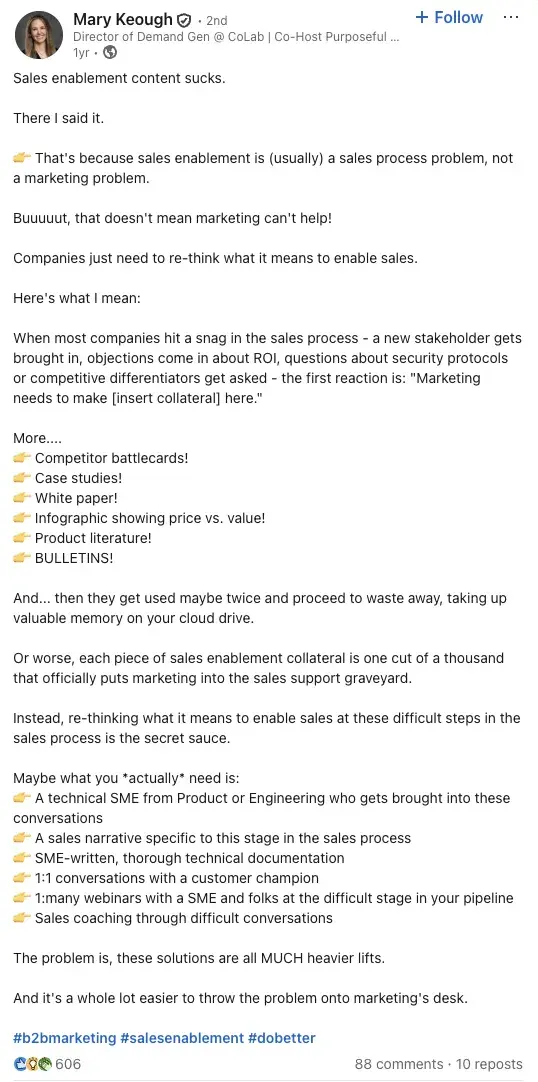
Her observation points to how most enablement content gets created in response to a gap someone noticed, not from systematic analysis of where reps get stuck.
A new competitor emerges, so marketing rushes out a battlecard. A deal stalls on ROI, so someone builds a calculator.
But these one-off responses miss the pattern.
The better approach starts with listening to sales calls — not cherry-picked wins, but the messy middle conversations where reps stumble that answer:
- What questions do they avoid asking?
- Where do they defer to managers?
- When do they promise to “circle back” instead of answering on the spot?
These moments show what reps need to say with confidence but can’t. Build your enablement roadmap from that reality.
2. Build content that works across multiple touchpoints.
A rep discovers a pain point on a call, sends a follow-up email referencing that conversation, and then needs something visual to share with the three stakeholders who weren’t in the room.
If your enablement content only works in one of these moments, reps will improvise the rest — and consistency falls apart.
Founder of Productive PMM and DemoDash, Jason Oakley’s “Know, Say, Show” framework maps directly to this reality:
- Know covers the background information reps need before any conversation — how your product works, what problems it solves, which customers have seen results
- Say gives them the exact language — the talk tracks for discovery calls, the email templates for follow-ups, the objection responses when someone pushes back on price
- Show provides the visual assets — the one-pager that summarizes your migration process, the case study that proves ROI, the slide deck they can walk through on a screen share.
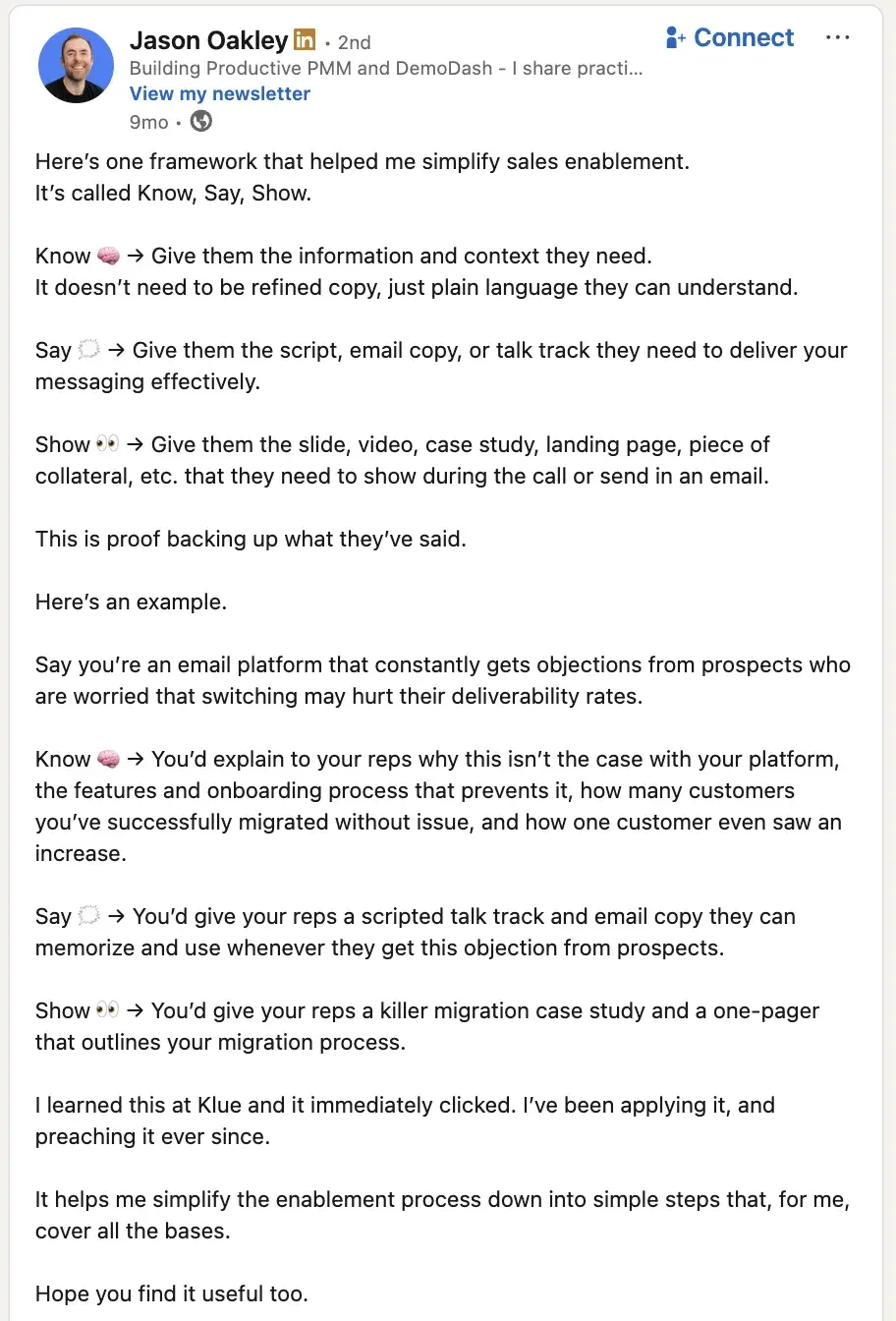
The same core message needs to travel through all three formats.
When a rep explains your security approach on a call (Say), they should be able to point to a technical doc that details it (Know) and send a one-pager their champion can share internally (Show).
With the same benefits, same proof points, same language, reps can move prospects forward with confidence in every interaction.
3. Make your content easy to find and share.
The best enablement content in the world does nothing if reps can‘t find it when they need it. Say a prospect asks about your enterprise security features, and the rep knows there’s a great one-pager somewhere. But after scrolling through three folders and two Slack channels, they give up and wing the answer instead.
Ron Baden, Head of Sales at GTM Buddy, uses a storage unit analogy in The Cyber Go-To Market podcast to describe this problem:
“If we could organize content so I could instantly know where it was and get what I need — my life would be dramatically different. That‘s what enablement has become for content. How do we give reps that one piece of information that’s going to make that one play work in the moment they need it to work?“
Organization matters more than volume. Tag content by buyer persona, deal stage, and common objections. Surface materials in the tools reps already use — their CRM, their calendar, their inbox.
The faster they can grab what they need, the more likely they’ll use it.
4. Tie enablement content directly to revenue metrics.
Enablement teams that can’t connect their work to revenue may find themselves fighting for budget or justifying headcount.
Lee Densmer, a content marketing leader, puts it plainly: sales can’t do their jobs without content in 2025, which means content teams own a piece of the sales outcome.
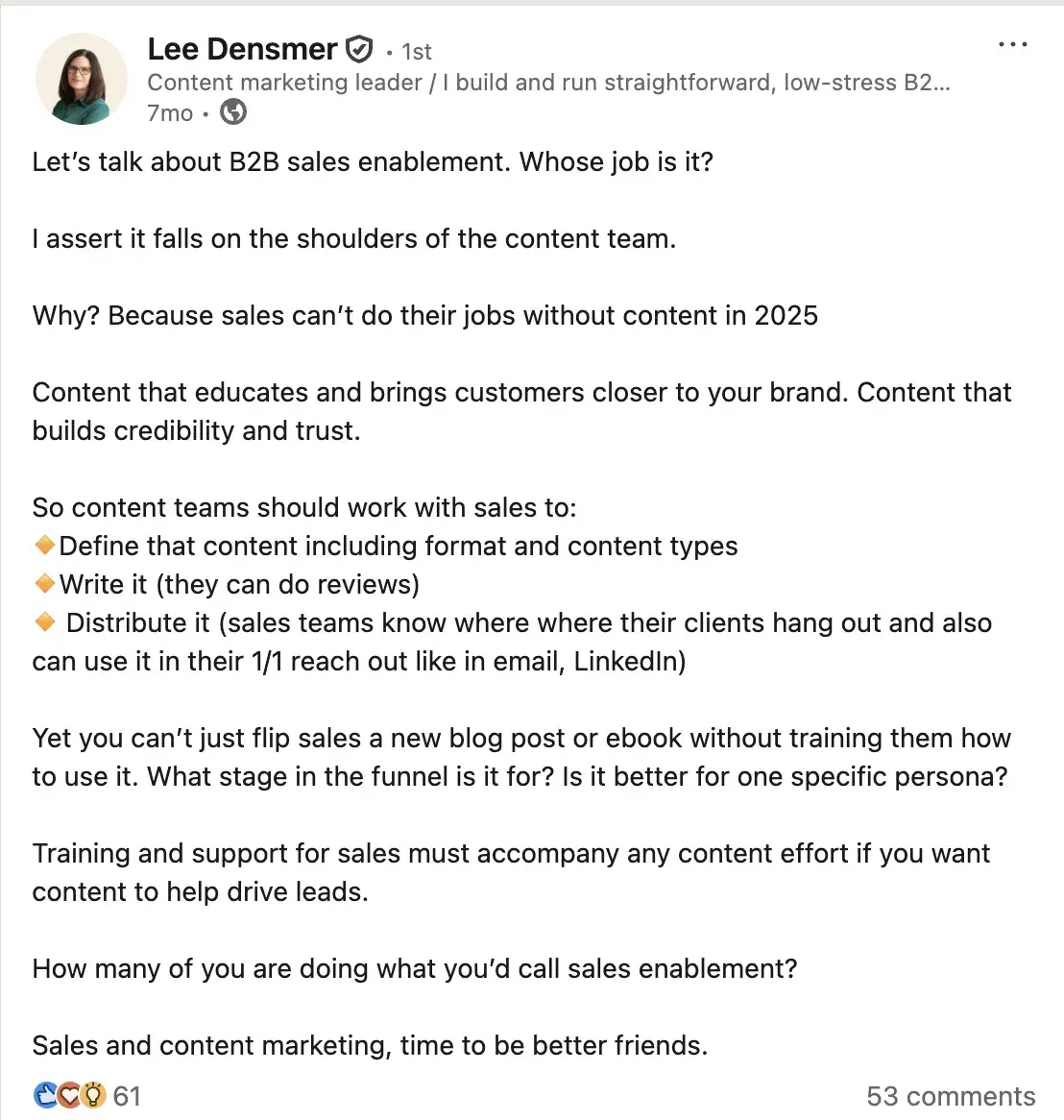
Her argument centers on training and support. You can’t hand reps a new blog post or ebook without showing them when to use it, which persona it works for, and what stage of the funnel it supports.
Without that context, content sits unused while reps improvise their own materials or lean on what they already know works.
The data from our report backs this up. With 42% of teams measuring success by ARR and 30% by profit margin, enablement content needs to prove it moves those numbers.
That means tracking which assets appear in closed-won deals, measuring how content usage correlates with conversion rates, and identifying which materials shorten sales cycles.
Sneha Mittal at Philips connects AI-powered enablement directly to business outcomes. She highlights in the Sales Enablement Innovation podcast: “AI can really help in generating more pipeline, prospecting better with AI-enabled insights, building and growing customer relationships, closing more deals, and shortening sales cycles.“
When you can draw a line from a specific piece of enablement content to shortened sales cycles or higher win rates, budget conversations get a lot easier.
Real World Sales Enablement Tips
1. Use role-play to practice the parts reps struggle with most.
Most sales training tries to cover everything at once — discovery, demo, objection handling, and closing.
Representatives sit through two-hour sessions and retain 20% of the information. The better approach zeroes in on the specific moments when deals fall apart.
Ron recommends focusing practice on weak spots:
“Before they get on the call, have them just redo a five-minute role play of the section of it that they’re not great at.“ He suggests using real call data to build these scenarios. ”Take the last 15 CISO calls that the team had. Here’s the transcript. Feed that into the knowledge base for the role-play engine.“
Molly Sestak, who built enablement at companies like Okta and Showpad, saw this work in practice. In the Sales Enablement Innovation podcast, she highlighted how she created an objection-handling game using Wheel of Fortune, where “you spin the wheel and you immediately have to answer an objection.”
The focus on one skill at a time built confidence faster than full call rehearsals. As she puts it, the key is identifying where your team struggles — whether it’s “pitching personas” or handling specific objections — and building repeatable practice around just that moment.
2. Eliminate 40% of non-selling work so reps have time to use enablement.
Your reps might ignore your enablement content not because it‘s bad, but because they don’t have time to use it. Between updating CRM fields, preparing for deal reviews, and searching for answers to prospect questions, the actual selling gets squeezed into whatever hours remain.
Ron sees this pattern repeatedly: “I can‘t tell you how much people underestimate the amount of busy work we can take away from sellers. I’m learning there’s about 40% of waste in the obvious things, updating the CRM, running deal reviews.”
His recommendation? Stop hiring more reps to hit capacity and start eliminating the work that keeps current reps from selling.
Deal reviews offer a clear example. Most teams spend 30 minutes per deal rehashing what happened — where the lead came from, who attended the last call, and what objections came up.
Baden suggests flipping this: “Why not do a go-forward deal prep? That‘s a great use of time for a sales leader to be on a call with someone and say, here’s how we‘re gonna go win this call, and let’s practice it.“
The same principle applies to content prep. If finding the right case study takes 15 minutes of searching through folders, reps will improvise instead. If CRM updates demand perfect data entry before they can move to the next stage, they’ll batch it all on Friday afternoon when they should be prospecting.
Remove the friction first, then watch the adoption of your enablement materials increase.
3. Use AI to tailor enablement to different stakeholders in the buying committee.
B2B deals rarely hinge on a single decision-maker. A hospital might have a CIO focused on system integration, a Chief Nursing Officer worried about workflow disruption, and a procurement lead evaluating the total cost of ownership. Each needs different information, but most reps get trained on a single pitch.
Sneha uses AI-powered role-plays to prepare reps for these varied conversations. She explains the challenge: “Selling into hospital networks is quite complex, because you’re not just speaking to one decision maker. You’re really navigating a matrix of clinical, operational and IT leaders, each with their own priorities.”
Rather than generic training, her team creates detailed stakeholder personas. “A hospital CIO is often focused on system interoperability, data security, and ensuring that any new solution that they take integrates seamlessly with their existing EHR platforms.
And that’s a very different conversation than the one you would have with the chief nursing officer or a procurement lead.“
The AI simulates these conversations, challenging reps to adapt their messaging in real time. After each session, it provides feedback on whether they aligned with stakeholder concerns or missed the mark.
4. Focus on outcomes first, then work backwards to skills and knowledge.
When building enablement programs, it’s tempting to start by cataloging everything reps need to know — product features, competitive differentiators, pricing structures. Knowledge transfer feels productive and measurable.
Jeff Jorski, who built Google’s award-winning sales coaching program, reworks this model. He starts with the outcome the business needs, then identifies the specific skills required to deliver it. “What’s the outcome we’re trying to drive? First and foremost…Then you get into it to drive that outcome, what do they need to know, and what do they need to do.”
For Google’s coaching program, the outcome was clear: drive more effective customer meetings. This led to focusing on skills like properly opening and closing meetings, running structured discovery, and using stories instead of stats to communicate value.
When you define the outcome first — whether it’s shortening sales cycles, improving win rates, or increasing deal size — you can work backwards to identify which behaviors will move that number, then build enablement content around practicing those behaviors.
Move from theory to practice.
I’ve spent years watching enablement teams create content that sits unused while reps improvise their own materials.
The pattern is always the same: content built in isolation from the conversations reps have, deployed when it’s convenient for the enablement calendar, and measured by completion rates instead of revenue impact.
The data from this year‘s State of Sales shows what works: teams are moving toward solution-based selling, expanding self-serve tools, and focusing on customer goals. Your job is to build enablement content that supports those shifts with materials reps can use immediately in the deals they’re working right now.
You can download the full State of Sales report below to see all the data I referenced throughout this article.
![]()

![Download Now: 2025 Sales Trends Report [New Data]](https://no-cache.hubspot.com/cta/default/53/9cdc68ed-d735-4161-8fea-0de2bab95cef.png)